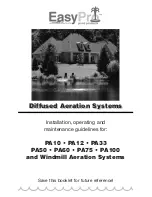
YK11-0016-DI-002-08
54
5.6.1 Preparation
The separate exhaust port of the lubricating chamber is at the center of the oil trap flange (B) on the
top on the motor-side cover. It is covered with a plug to keep off foreign matter on delivery.
(1) Remove the plug from the separate exhaust port of the lubricating chamber.
(2) Arrange the piping to the separate exhaust port and the inlet port of the lubricating chamber.
CAUTION
The ultimate pressure of the pump for separate evacuation of the
lubricating chamber should be equivalent to that of the fore pump.
5.6.2 Water Piping, Electrical Connection and Lubrication.
Follow the procedure in the “3.2” , “3.5” , “3.6”.
5.6.3 Checking lubricating oil level
Follow the procedure in the “3.2” , “4.1” , “4.2”.
5.6.4 Oiling mechanical seal
Follow the procedure in the “3.2” , “4.1” , “4.2”.
5.6.5 Pumping
(1)
Close the inlet port either by closing the valve above the inlet side of the mechanical booster
pump or by providing a blind flange to the intake port.
(2)
Run the pump for evacuating the lubricating chamber to evacuate the lubricating chamber
of the mechanical booster pump.
Then run the backing pump to evacuate the mechanical booster pump.
Here, make sure that the pressure at the inlet port or exhaust port of the mechanical booster
pump lowers to near the ultimate pressure of the backing pump (13 to 1.3 Pa with the
standard backing pump).
If the pressure does not lower, check the piping for leakage or the backing pump for defect.
Follow the procedure in the “4.1”, “4.2” Operation”.
5.6.6 Checking rotational direction
After completion of evacuation check the rotational direction.
Run the pump for approximately three second while looking through the viewing port.
If the gears rotate in the direction shown in the “Fig. 17”, it is running in the normal direction.
If the rotation is reversed, interchange the two wires of the three input wires to the motor.
If there is a vacuum gauge on the inlet side of the mechanical booster pump, the rotational direction
can be checked by running the mechanical booster pump to see if the pressure lowers.
Follow the procedure in the “4.1”, “4.2” Operation”.
Summary of Contents for PMB100D
Page 2: ......
Page 3: ...Declaration of Conformity...
Page 39: ...YK11 0016 DI 002 08 12 2 4 Dimensional drawing Fig 11 Dimensional drawing PMB100D...
Page 40: ...YK11 0016 DI 002 08 13 Fig 12 Dimensional drawing PMB300D...
Page 41: ...YK11 0016 DI 002 08 14 Fig 13 Dimensional drawing PMB600D...
Page 42: ...YK11 0016 DI 002 08 15 Fig 14 Dimensional drawing PMB1200D...
Page 43: ...YK11 0016 DI 002 08 16 Fig 15 Dimensional drawing PMB2400D...
Page 62: ...YK11 0016 DI 002 08 35...
Page 65: ...YK11 0016 DI 002 08 38...
Page 72: ...YK11 0016 DI 002 08 45...
Page 84: ...YK11 0016 DI 002 08 57 Fig 28 PMB300D Optional attachment figure...
Page 85: ...YK11 0016 DI 002 08 58 Fig 29 PMB600D Optional attachment figure...
Page 86: ...YK11 0016 DI 002 08 59 Fig 30 PMB1200D Optional attachment figure...
Page 89: ...YK11 0016 DI 002 08 62 Fig 33 Dimensional drawing PMB2400D Horizontal exhaust model...
Page 99: ...YK11 0016 DI 002 08 72...
Page 105: ...YK11 0016 DI 002 08 78...
Page 119: ......
















































